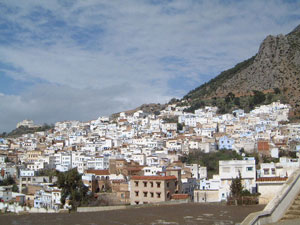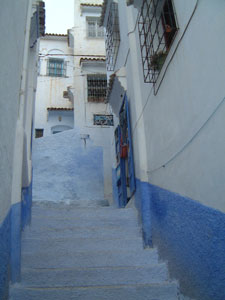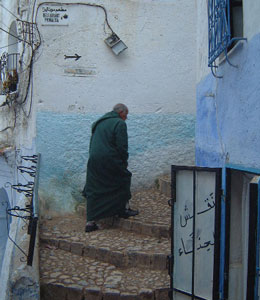|


      
|
Postcards
from Chefchaouen
 Chefchaouen
is a quaint little town, nested on the flank of a Rif hill (the Rif mountain
range is the furthest North mountainous region in Morocco, just South
of Tangier and the Mediterranean)- its white and blue walls, narrow little
streets and Spanish speaking inhabitants cast an ancient shadow over the
town, a feel of older days, when life was a bit slower, a bit calmer.
We are not the first to find this town beating at the rhythm of days past-
when the Spanish colonized Chefchaouen in the early 20th century, they
were quite surprised to hear its inhabitants speak medieval Castilian;
a remnant of the XVth century exodus of Andalusian Muslims and Jews away
from Christian Spain. Chefchaouen
is a quaint little town, nested on the flank of a Rif hill (the Rif mountain
range is the furthest North mountainous region in Morocco, just South
of Tangier and the Mediterranean)- its white and blue walls, narrow little
streets and Spanish speaking inhabitants cast an ancient shadow over the
town, a feel of older days, when life was a bit slower, a bit calmer.
We are not the first to find this town beating at the rhythm of days past-
when the Spanish colonized Chefchaouen in the early 20th century, they
were quite surprised to hear its inhabitants speak medieval Castilian;
a remnant of the XVth century exodus of Andalusian Muslims and Jews away
from Christian Spain.
 Rachel
and I walked the blue streets, with the blue lights and the blue tastes-
wandering aimlessly in labyrinths of steep pathways and tiny doorways.
At each corner, at each new bend in the road, the path opened up onto
a new photographic marvel, a feast for the eyes: we kept our cameras ready,
ceaselessly amazed at the never ending succession of beauty and light.
There was one slight problem though- people ran from our lenses as they
would from guns or knives, shouting vigorous "Non" at our innocent
frames. Chefchaouis would rather be caught dead than on film. Rachel
and I walked the blue streets, with the blue lights and the blue tastes-
wandering aimlessly in labyrinths of steep pathways and tiny doorways.
At each corner, at each new bend in the road, the path opened up onto
a new photographic marvel, a feast for the eyes: we kept our cameras ready,
ceaselessly amazed at the never ending succession of beauty and light.
There was one slight problem though- people ran from our lenses as they
would from guns or knives, shouting vigorous "Non" at our innocent
frames. Chefchaouis would rather be caught dead than on film.
Many humorous
episodes featured Rachel's 200 millimeter zoom fighting reticent bypassers.
A typical scene involves innocent children running down steps, facing
the camera in fear and disbelief, stalling and scattering in all directions,
trying desperately to avoid the camera's angle...
But
what makes the Chefchaouis run?
Well, its a bit of everything. First, it's common
sense. No one likes to be in some random tourist's picture, and certainly
not when you know that this random tourist has some strange concept of
'exoticism' that you are supposed to illustrate. 3 centuries of Orientalist
press have vaccinated every Moroccan against the Western lens...

Yet it is more than that- it's more than a First world v. Third World,
tourist v. local combat; it's also about Islam and the concept of image
in Islamic tradition (see Words and
Images for more on this). At different times and in different places,
interpreters of Muslim law have issued more or less stringent guidelines
on the role of pictural representation. The strictest interpretations
forbade the representation of any living being altogether, making picture
taking an un ambiguously blasphemous activity.
Chefchaouen is not only quaint in its look and feel; it is also quaint
in its ways. People live and believe here as they did 50 years ago in
other Moroccan communities- their fear of photography has a little something
to do with this general fear of representation; this general belief that
only God has the right to depict a human being.
So eager
to complement our short-lived memories with longer lasting pictures, Rachel
and I found solace in less controversial beings (lambs and posters don't
complain much?) -catching the occasional 'careless' Chefchaoui!
|